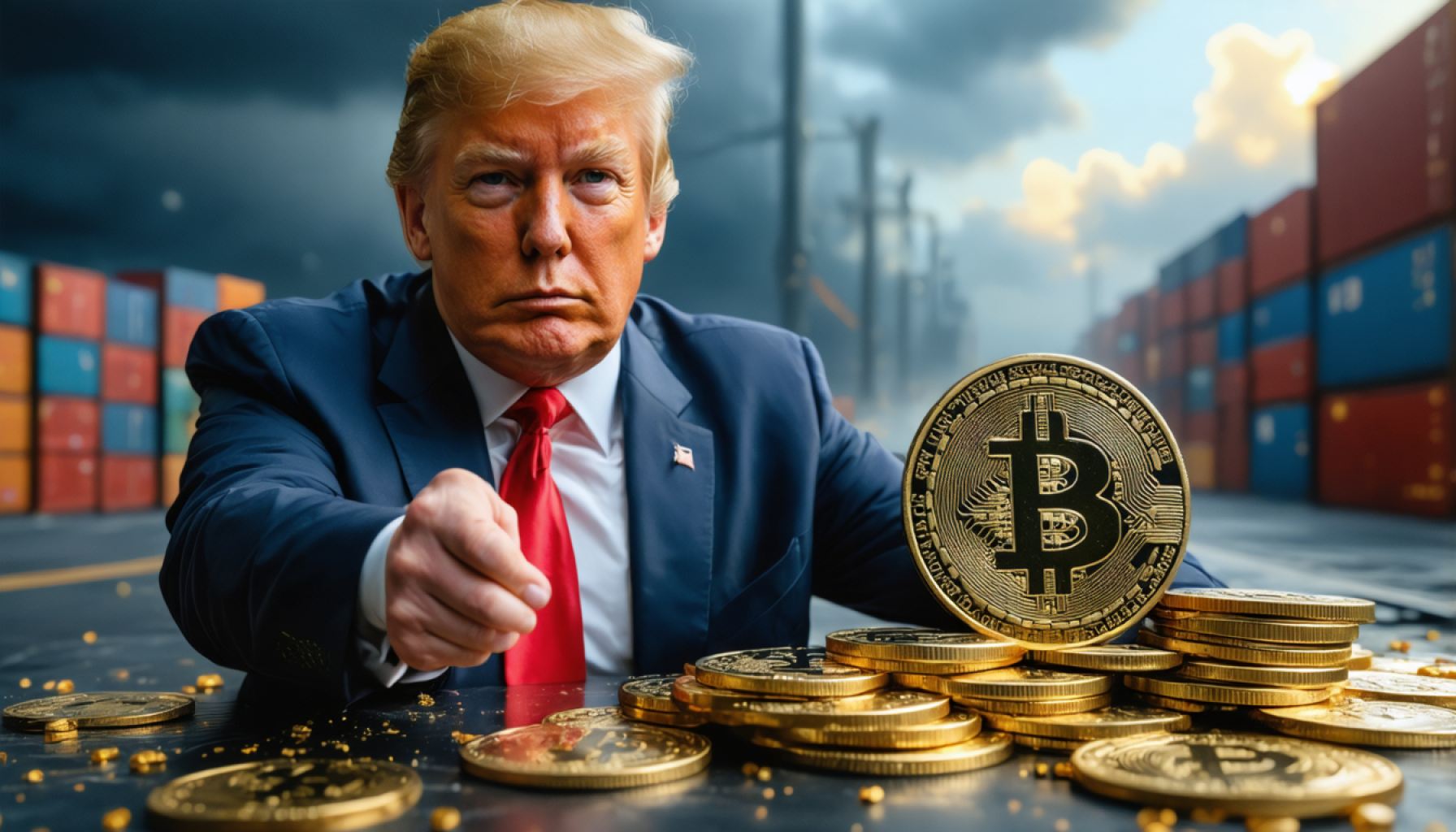- Bitcoin (BTC) faces volatility due to recent import tariffs introduced by former President Donald Trump.
- The cryptocurrency’s value has dropped over 15% in the past quarter, contrary to initial bullish expectations.
- Traders show signs of selling at a loss, as indicated by a lower profit/loss ratio, suggesting a potential saturation point in selling.
- Bitcoin struggles to break through the $85,257—$95,300 resistance corridor, hindered by unrealized losses.
- Future price recovery could hinge on changes in U.S. policy, including potential tax reforms or crypto regulation updates.
- Bitcoin’s trajectory remains uncertain, reflecting the tight interplay between global policy dynamics and decentralized finance.
- Investors should prepare for volatility, as fiscal decisions may open new opportunities in the digital finance landscape.
Amidst the turbulent waves of announcements reverberating from Washington, a peculiar ripple of uncertainty unsettles the serene waters of the cryptocurrency narrative. Bitcoin (BTC), the maverick of digital assets, finds itself riding a roller coaster of reactions in response to former President Donald Trump’s recent decree on import tariffs.
These tariffs—introduced with the fanfare of a new dawn—have ironically cast a shadow over many sectors, with Bitcoin now lumbering under the weight of broader economic implications. In the aftermath of this policy shift, Bitcoin finds its place in a curious bind. Within the past quarter, its value has plummeted more than 15%, betraying the bullish expectations set during the start of Trump’s tenure. It’s not the expected trajectory for this formidable digital coin.
Street wisdom among cryptocurrency circles hints at a notable shift in behavior. While geopolitical chess plays out on the global stage, on-chain signals indicate a tempered selling frenzy—traders seem to be locking in losses more than profits, evidenced by a declining profit/loss ratio. This quasi-silent market epoch stirs the notion that sellers might be hitting a saturation point. Yet, the market shall remain vulnerable to volatility, a tempest waiting for a trigger as sentiments wag perilously in the wind.
Delving deeper into market analytics reveals that Bitcoin faces formidable resistance in breaching the much-vaunted $85,257—$95,300 corridor. A veritable fortress crafted from unrealized losses looms over potential price recovery, testing the resilience of every bullish breakout attempt. It’s a numbers game that threatens to trap Bitcoin in this economic purgatory unless fresh capital injects new life.
Though short-term speculation might suggest a bearish hue, a potential saving grace could lie in the unlikely hands of the Trump administration itself. With policy twists on taxation or refinements in crypto regulation, the very authors of current market unease might unfurl a roadmap leading back towards the $100,000 milestone.
The takeaway? In the ever-connected dance of global policy and decentralized finance, Bitcoin’s future unfurls both as a perilous challenge and a boundless opportunity. Investors and onlookers alike should brace themselves for an unpredictable ride, where every fiscal decision could herald the dawn of new opportunities. Balancing speculation with caution, the next move could be the one that shifts the paradigms of digital finance as we know it.
Unraveling the Impact of Tariffs and Policies on Bitcoin’s Volatile Journey
Understanding Bitcoin’s Recent Roller Coaster Ride
Bitcoin’s volatility is often influenced by macroeconomic policies, and recent import tariffs introduced by Donald Trump have added another layer of complexity. Here’s a deeper dive into how these geopolitical events are influencing Bitcoin, alongside some practical advice for investors navigating these turbulent times.
How Do Import Tariffs Affect Bitcoin?
While it may seem indirect, import tariffs can significantly impact Bitcoin in several ways:
1. Investor Sentiment: Tariffs can lead to unpredictability in currency and commodity markets. This volatility often spills over into cryptocurrencies, as investors seek alternative assets to hedge against inflation or currency devaluation.
2. Economic Uncertainty: Import tariffs can have widespread effects on the global economy, potentially leading to recessions or downturns. Economic uncertainty typically drives investors towards perceived safe-haven assets, although Bitcoin’s role as a safe-haven is still debated.
3. Capital Flows: As traditional markets react to tariffs, capital might flow into or out of cryptocurrencies based on the perceived stability or potential returns.
Bitcoin Market Analysis: The Current Landscape
1. Resistance Levels: Cryptocurrency analysts have identified significant resistance levels for Bitcoin between $85,257 and $95,300. Breaking through these levels is essential for a bullish trend reversal.
2. On-Chain Metrics: Recent data suggests that more traders are selling at a loss rather than a profit, a sign of market pessimism. However, this could also mean an impending market saturation point, possibly leading to stabilization.
Strategies for Navigating Bitcoin’s Terrain
1. Diversification: In times of uncertainty, diversifying your investment portfolio can help mitigate risks. Consider a mix of stablecoins, altcoins, and traditional assets.
2. Long-Term Perspective: The volatility in the crypto market underscores the importance of holding a long-term perspective. Historically, Bitcoin has recovered from significant downturns.
3. Stay Informed: With regulations and policies continuously evolving, staying informed is essential. Follow credible sources and expert analyses to make informed decisions.
Future Predictions and Trends
1. Regulatory Changes: Future policy changes, including potential revisions to cryptocurrency taxation and regulation, could significantly impact the Bitcoin market.
2. Institutional Adoption: As more institutions adopt Bitcoin, the cryptocurrency could become less volatile. This institutional interest might create a more stable price floor.
3. Technological Advancements: Blockchain technology’s evolution and Bitcoin’s scalability improvements might increase its utility, thereby attracting more users and investors.
Recommendations for Bitcoin Investors
– Risk Assessment: Evaluate your risk tolerance and adjust your portfolio accordingly. Use tools like stop-loss orders to protect your investments from extreme volatility.
– Embrace Volatility: Use volatility to your advantage by employing strategies like dollar-cost averaging (DCA), which can mitigate the impact of short-term price fluctuations.
Conclusion
The interplay between global policies and cryptocurrency markets demands vigilance and adaptability. While Bitcoin’s path remains murky, opportunities abound for those who strategically navigate the hurdles. Stay informed, remain flexible, and embrace the market’s unpredictability as opportunities for growth.
For more insights and updates, visit the official website of Bitcoin.
